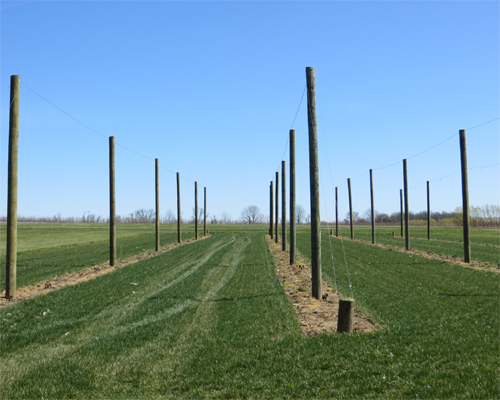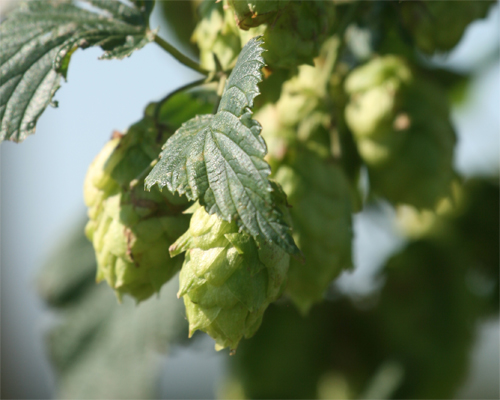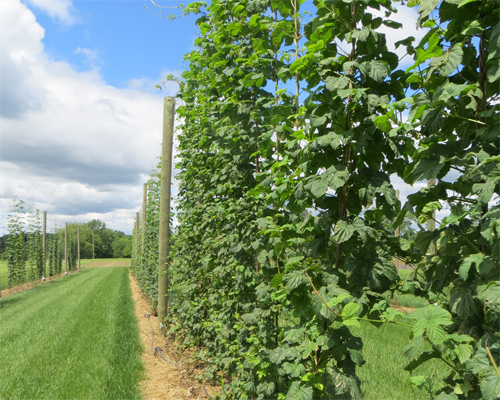
Fact Sheet FS1276
What are hops?
The hop plant (Humulus lupulus) is a hardy perennial that produces annual vines from an overwintering rootstock. The vines are also known as bines due to their growth habit of stems wrapping in a circular fashion around objects as they grow upward.
What are hops used for?
The principal use of hops is in the production of beer. The female hop cone has resin glands that produce lupulin. Lupulin contains oils and resins that produce the aroma and bitterness in beer.
Are all hops the same?
There are both aroma and bittering hops. There are many different varieties of hops. Just as a chef uses spices to add distinct flavors to a recipe, brewers use hops to create distinct beers. Brewers select different hops varieties to supply both the flavor and aroma palate they are seeking when crafting a beer. It is not unusual that several varieties of hops are used in producing a single craft beer. It is for this reason it is recommended to conduct some market research and talk with local brewers before selecting varieties to plant.
Besides beer making, are there other uses of hops?
There have been numerous reports and claims of medicinal benefits regarding hops. These include relieving anxiety and sleeplessness. Hops are also reported to have preservative properties. Hops have been used in soaps, teas, pillows, and a variety other products beyond beer. The bines from hop plants have also been used to make decorative wreaths.
Is there a demand for locally produced New Jersey hops?
Similar to the consumers desire to source and purchase locally-produced fruits and vegetables, consumers have indicated a wish for locally produced beer using locally sourced ingredients.
The resurgence of local brewing in America is certainly evidenced by the more than 4,000 active breweries in the United States. The Brewers Association reports that this is the first time the United States has crossed the 4,000-brewery barrier since the 1870s. The rise of the local food and drink movement has led to brewers seeking locally sourced ingredients like honey, fresh fruit, malting barley, and hops.
Be aware that supplying locally produced hops in New Jersey can offer challenges with on-farm infrastructure, harvesting, and processing expenses that must be considered on a case-by-case basis. Before attempting to plant a hops yard, it is recommended to conduct market research to determine who will purchase your hops, approximate sale price, what varieties your customer is looking for, and whether the customer is seeking fresh or pelletized hops.
What site characteristics are best for planting hops commercially?
It is important that some thought and consideration be given to where you locate your hops yard for commercial production. The site selected should be well drained—preferably flat or with a gentle slope—and have good air circulation and full sun. Trellis poles are typically 20 feet long and placed 4 feet deep. Consider if any conditions such as overhead electrical lines or shallow bedrock may limit installation. Also if appropriate, consider the depth to bedrock, as poles must be placed 4 feet deep for safety and stability. Also, access to irrigation water is also important, as drought stress will hinder establishment, plant health, and longevity, and limit yield.
It is also recommended that a soil test be obtained prior to establishing a hops yard. This will determine if the soil should be amended with lime (hops prefer a soil pH of 6.0 to 6.5) or other nutrients prior to establishment. Trying to adjust pH or incorporate fertilizer into soil is not an easy task after planting is completed. It is recommended to determine recent cropping history of the proposed hop yard and to determine what if any herbicides were applied to the previous crop. Herbicide carry over in soil could potentially present a problem with the new planting.
It is recommended when starting a new hop yard to start as weed-free as possible prior to planting. Strategies to accomplish this may include cover cropping with tillage or possibly using a burn down herbicide application of glyphosate prior to planting. Timing of application is important. Always read and follow the label instructions before applying any pesticide.
What type of production system is used to produce hops commercially?
It has been routinely shown that maximum production is obtained using full-size plants on high trellises (16–20 feet high). Several different variations of a high trellis system are in use throughout our region. Typically, about 900 plants/acre are planted about 3 feet apart within rows, with a row spacing of about 12 feet apart. Some hop yards in our region space rows as far apart as 15 feet.
The installation of the infrastructure for the trellis system represents a substantial expense when establishing a hops yard. As there are several different variations in trellis system, the costs for establishing the trellis system can also vary. Several different production budgets report costs ranging from $6,500 to $12,000 per acre to establish a high trellis system.
Previous work at Rutgers University examined the use of a low trellis production system. The system used a 6-foot-high trellis. Results indicated that yield was sacrificed significantly, to the point of not being viable financially. In the Pacific Northwest there is some production using 10-foot-high trellises with plastic netting. This system requires substantial investment in special over-the-row harvesters. Disease management could be an issue when using lower trellis production systems, since less airflow through the plant canopy may raise moisture levels and increase disease occurrence.
What insect and disease pests are expected in New Jersey?
Some of the more common pests encountered in New Jersey include spider mites, leaf hoppers, Japanese beetles, European corn borer, and aphids. Hop merchant, also known as eastern comma (Polygonia comma), has also been encountered. The most significant of the pests encountered has generally been leaf hoppers. Leaf hopper feeding causes scorch or yellowing of the leaves. Downy mildew, the disease that contributed to the movement of hops westward, has also been encountered.
Is irrigation needed?
Hops generally need at least an acre-inch of water per week. More water is usually needed as the season progresses due to the large leaf area of the mature plants, which increases transpiration during the hot summer months. Most commercial growers opt to use drip irrigation with emitters spaced about 18 inches apart. Overhead irrigation results in wet foliage, which can increase the risk of plant diseases and is difficult to apply across the row due to the height of the bines.
What are training and stringing hops?
Tall trellis systems require labor-intensive practices such as stringing and training. Stringing involves tying coir twine from the overhead trellis wires, dropping them to the ground, and then staking into the hop rows. The hop vines will grow up the strings to the top of the trellis. The hop vines don't grow on strings naturally, they have to be given a head start. The best three or four hop bines are chosen at each string and then wrapped clockwise around the string. The hop bines attach themselves to the strings with tiny hairs. Once wrapped in place, the bines will figure out the rest of the way up the strings and over the trellis wires. The remaining bines should be pruned to ground level.
How are hop cones harvested?
In the large commercial hop yards in the Pacific Northwest, the hop bines are cut at the top and bottom and brought to a commercial harvester machine in a hops processing facility. Small-scale harvesters such as a Wolf harvester or Bine Implement Harvester are in use in New York State and Michigan. Small-scale harvesters can cost as much as $30,000 or more. There are also plans available to construct small-scale harvesters. The capacity of these small scale harvesters can vary, but are often reported as being capable of harvesting up to a 1/3 of an acre per day. The cost of small-scale harvesters is generally cost-prohibitive to newly started small-scale growers. That generally leaves hand harvesting as the only option for many. Hand harvesting is a labor-intensive process and may not be a cost effective option. It is generally reported that it requires about one person hour per mature plant. Research conducted at Rutgers University in 1996 reported that on average 0.25 pounds (dry weight) of hops was harvested per hour by hand picking with one person.
Where can I go to gain additional information about growing hops?
The Northeast Hop Alliance is a good source of useful information about producing hops in our region. The Northeast Hop Alliance is a broad-based coalition established to explore the feasibility of re-establishing commercial specialty hops production in New York and the Northeast. The resources page of the Northeast Hop Alliance contains many articles and presentation that may be useful to the novice hops producer.
Mention or display of a trademark, proprietary product, or firm in text or figures does not constitute an endorsement by Rutgers Cooperative Extension and does not imply approval to the exclusion of other suitable products or firms.
June 2017
Copyright © 2025 Rutgers, The State University of New Jersey. All rights reserved.
For more information: njaes.rutgers.edu.
Cooperating Agencies: Rutgers, The State University of New Jersey, U.S. Department of Agriculture, and Boards of County Commissioners. Rutgers Cooperative Extension, a unit of the Rutgers New Jersey Agricultural Experiment Station, is an equal opportunity program provider and employer.



